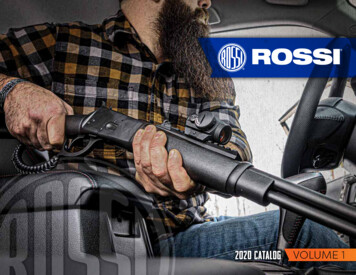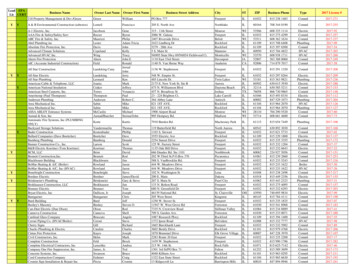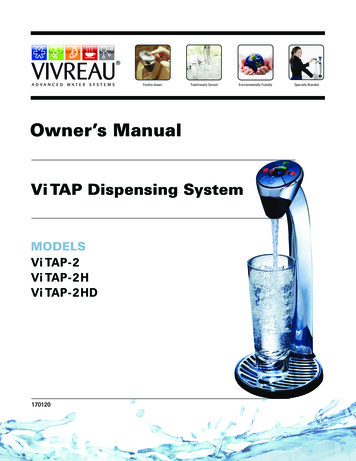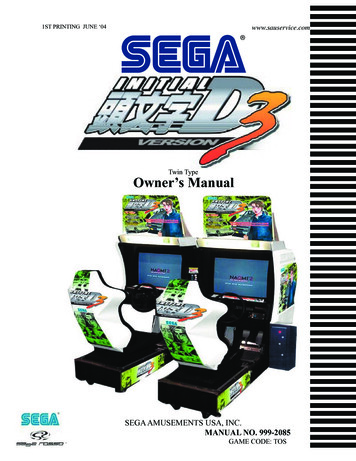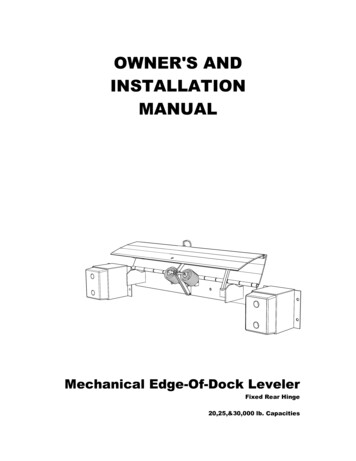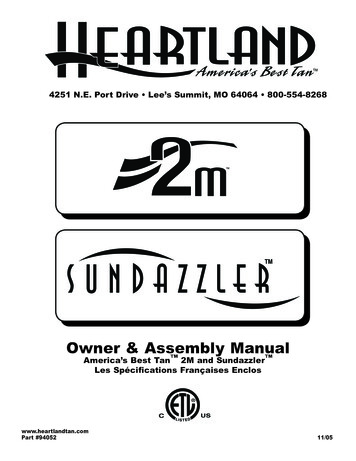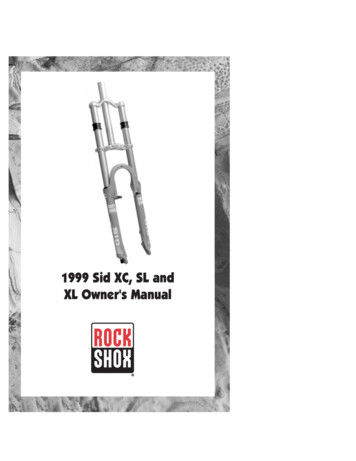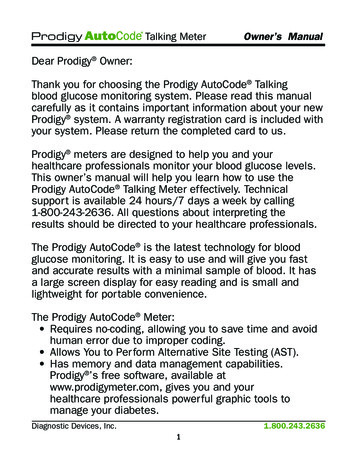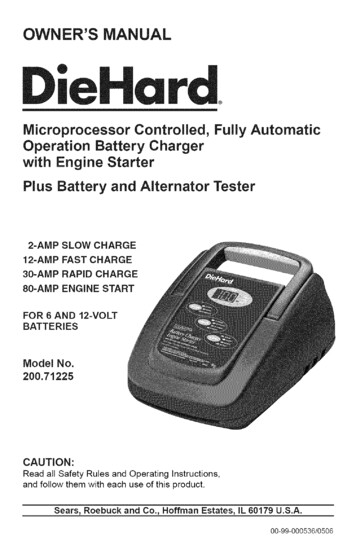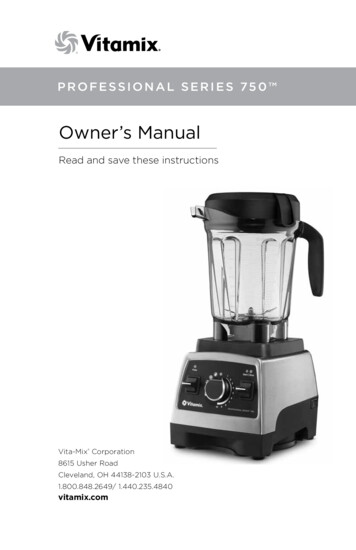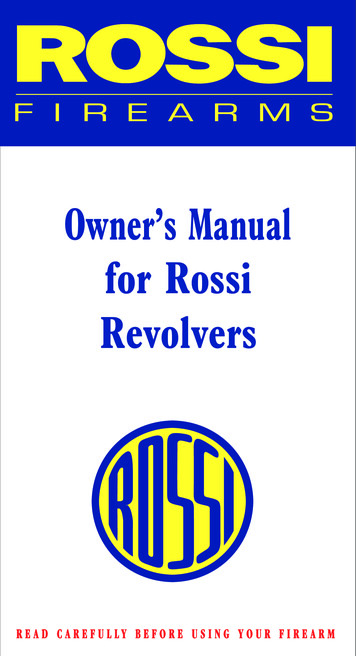
Transcription
Owner’s Manualfor RossiRevolvers
This BookletThe safety warnings in this booklet are important. By understanding thedangers inherent in the use of any firearm, and by taking the precautionsdescribed herein, you can enjoy complete safety in the use of your revolvermanufactured by Taurus and branded as Rossi. Failure to heed any of thesewarnings may result in serious injury to you or others, as well as severedamage to the firearm or other property.Dangerous WeaponsREVOLVERS are classified as FIREARMS or DANGEROUS WEAPONSand are sold by us with the specific understanding that we are not responsiblein any manner whatsoever for their improper or negligent handling or resaleunder local laws and regulations.TAURUS shall not be responsible in any manner whatsoever formalfunctioning of the firearm, or for physical injury or property damage,resulting in whole or in part from (1) criminal or negligent discharge, (2)improper or careless handling, (3) unauthorized modifications, (4) defective,improper hand-loaded, or reloaded ammunition, (5) neglect, or (6) otherinfluences beyond our direct and immediate control. This limitation appliesregardless of whether liability is asserted on the basis of contract, negligenceor strict liability (including any failure to warn). Under no circumstance shallTAURUS be liable for incidental or consequential damages, such as loss ofuse of property, commercial loss and loss of earnings or profits.WarningFailure to properly secure a firearm may result in injury or death.WarningTo prevent injury or death, it is imperative that you must keep your gununloaded, uncocked, and securely locked, with ammunition in separatelocation. In addition, take any other reasonable steps to limit the possibility oftheft, accident, or suicide.ALWAYS KEEP THE MUZZLE POINTED IN A SAFE DIRECTION.3
Revolver with Taurus Security SystemThe Rossi revolver is equipped with the exclusive“Taurus Security System.” The system is designed topreclude use of the weapon when the mechanism isengaged. It consists of an integral mechanism locatedin the hammer (Fig.A).When properly engaged by use of the key, it preventsthe functioning of the revolver. The engagement of themechanism can only be done utilizing a special keythat fits the activation pin.Engagement (Secure)Fig.AFig.BTo engage the system, it is necessary to insert the keyinto the activation pin and turn it clockwise until a“click” is felt or heard (Fig.B). In this position, therevolver’s mechanism is locked and the pin protrudesabove the surface of the hammer(Fig.1B)Disengagement (Ready-to-Fire)To place the revolver in a firing condition, you mustinsert the key in the security mechanism pin and turnthe key counter-clockwise (Fig.C). In this position thetop of the pin is in the same plane with the hammersurface (Fig.1C). The revolver is now ready to fire.Fig.1BWarning:All handguns must be kept out of the reach of childrenor persons not authorized to use them. Ammunitionshould be kept separated from the handgun. Never Fig.Cfully rely on any safety or security mechanism. It is nota substitute for safe and cautious gun handling. Nosafety or security mechanism, however positive orwell designed, should be totally trusted. Like allmechanical devices, the safety or security system issubject to breakage or malfunction and can beadversely affected by wear, abuse, dirt, corrosion,incorrect assembly, improper adjustment, repair, orFig.1Clack of maintenance.Moreover, there is no such thing as a safety which is“childproof” or which can completely preventaccidental discharge from improper usage,carelessness or “Horseplay”.4ALWAYS KEEP THE MUZZLE POINTED IN A SAFE DIRECTION.
WarningSecuring your firearm may inhibit access to it in a defense situation andresult in injury or death.NOT JUST FOR BEGINNERSRegardless of your familiarity or experience with firearms, you need tostudy this manual.The safe handling of firearms requires specialized training, discipline andcaution. Firearms, by their nature and intended function, are deadlyinstruments. Accidental death or serious injury can result if they are handledimproperly or carelessly.Firearms rarely cause accidents. Firearms accidents almost always arecaused by a failure to obey the basic rules of gun safety. Unfortunately,experienced shooters are found to violate these rules as frequently asbeginners. Thus the basics of safe firearms handling cannot be repeated toooften.Read, re-read and memorize the basic principles of firearms safetyuntil they become second nature: habits that you don’t forget.If you have any question about your knowledge or ability to use this or anyother firearm with complete safety you should seek supervised instruction.Personalized instruction is often available from firearms dealers, gun clubs,state hunter safety programs or police departments in the United States. Ifnone of these sources is accessible, write to the National Rifle Association,Washington, D.C. 20036.THEY WILL ASSIST YOU.A person with a firearm in his possession has a full-time responsibility. Hemust KNOW how to keep and use his firearm safely, and then must alwaysTAKE the precautions necessary – all of them. He cannot guess; he cannotforget. This responsibility is his alone. It cannot be passed off to someoneelse.Remember: no firearm can be made accident-proof. A firearm is just amachine, with no judgement of its own. It responds to your actions, whetherwise or foolish. The only truly effective safety device is the mind of acautious shooter who never forgets that a moment’s carelessness canproduce permanent tragedy.ALWAYS KEEP THE MUZZLE POINTED IN A SAFE DIRECTION.5
Guns Are Not AlikeMany makes and models of firearms might LOOK nearly the same.However, they differ widely in design and operation, and in the location andfunction of various controls.Study this manual thoroughly. Educate yourself on the characteristics andoperation of your particular firearm before attempting to handle it. Do notpermit others to handle it - unless they also have done so. You should havean instruction manual for every firearm you own. If you do not, write themanufacturer and obtain one. Most manufacturers will gladly send you onefree. If for any reason a manual is not available, visit your public library.Many books have been published which contain detailed information onobsolete or discontinued firearms.Your knowledge can prevent injuries.Rossi handguns are designed and made to offer maximum safety whencorrectly used. However, as with any other firearm, it is not foolproof,and may become very dangerous if the following basicrecommendations are not RIGIDLY observed:ATTENTIONRules of Firearms Safety1. DANGER: Never, never-ever point any gun, loaded or unloaded, atanything you do not intend to shoot.2. WARNING: Always treat every gun as if it were loaded.3. NOTICE: Get instruction from a competent firearms instructor beforeusing any gun.4. SAFETY FIRST: The safety is only a mechanical device, not asubstitute for common sense.5. WARNING: Keep your finger off the trigger until you are actuallyaiming at the target ready to shoot.6. WARNING: Be certain the gun is unloaded before cleaning.7. WARNING: Always empty gun before entering a place where there arepeople.8. SAFETY FIRST: Never leave a loaded gun unattended.9. SAFETY FIRST: Store gun and ammunition separately beyond thereach of children.10. WARNING: Don’t test the safety by pulling the trigger while the safetyis on unless you are absolutely sure the firearm is empty and you arepointing away from everyone.11. SAFETY FIRST: Be sure of your target and backstop before youshoot.6ALWAYS KEEP THE MUZZLE POINTED IN A SAFE DIRECTION.
12. WARNING: Guns and alcohol or drugs don’t mix.13. WARNING: Never pull a gun towards you by the barrel. Don’t climb atree or cross a fence with a loaded gun.14. DANGER: Load and unload with the barrel pointed in a safe direction.15. SAFETY FIRST: If a gun fails to fire when the trigger is pulled, keep itpointed at the target for at least 30 seconds. Sometimes slow primer ignitionwill cause a “hang” fire and the cartridge will go off after a short pause.16. SAFETY FIRST: Never shoot at hard flat surfaces or water, bullet mayricochet.17. DANGER: When receiving a gun always check that it is unloaded,(open cylinder to check if it is empty), even if you saw it done previously.18. DANGER: Never put your hand over the barrel of a gun.19. DANGER: Check ammunition to be sure it is the right size and caliber,and that it is not dented.20. SAFETY FIRST: Use a proper holster and draw only if you intend toshoot21. NOTICE: Never cock the gun until you are ready to shoot.22. SAFETY FIRST: Dry firing is bad for this gun, whether the hammerblock is engaged or not.23. DANGER: WHILE HANDLING ANY FIREARM, NEVERALLOW IT TO POINT AT ANY PART OF YOUR BODY OR ATANOTHER PERSON, NO HARM SHOULD RESULT IF YOU OBEYTHIS RULE, EVEN IFANACCIDENTAL DISCHARGE OCCURS.24. Revolvers have “SIDE BLAST” or “CYLINDER BLAST”, hot gasesand particles escaping at high speeds to the sides of the gun from theclearance gap between the cylinder and barrel. Keep people behind andaway from you and keep your hands and body clear of the sides of therevolver when firing.25. CAUTION: If there is any reason to suspect that a bullet is obstructingthe barrel, immediately unload the firearm and look through the bore.It is not sufficient to merely look in the chamber.26. SAFETY FIRST: Treat this gun as a precision instrument.27. WARNING: Old or reloaded ammunition may be dangerous. Werecommend against using it.28.SAFETY FIRST: Never carry handgun in your pocket, purse or waistband. Use a pistol case or proper holster with safety flap or strap.29.DANGER: Don’t try to change your gun’s trigger pull, becausealteration of trigger pull usually affects sear engagement and may causeaccidental discharge.30. DANGER: Never engage a gun lock on a loaded firearm.Write to us concerning any items or circumstances which might relate toyour safety and the operation of our products.ALWAYS KEEP THE MUZZLE POINTED IN A SAFE DIRECTION.7
WarningRossi revolvers are manufactured to perform properly with the original partsas designed. It is your duty to make sure any parts you buy are installedcorrectly and that neither replacements nor originals are altered or changed.Your gun is a complex tool with many parts that must relate correctly toother parts. Putting a gun together wrong or with modified parts can result ina damaged gun, danger and injury or death to you and others throughmalfunction. Always have a qualified gunsmith work on your gun.Protect Your EyesAnd EarsAlways wear adequate shooting glasses and ear plugs or “ear muff” typeprotectors whenever you are shooting.Always make certain that persons close to you are similarly protected.Unprotected eyes may be injured by powder, gas, carbon residue, lubricant,metallic particles or similar debris which may emanate occasionally fromany firearm in normal use.Without ear protection, repeated exposure to shooting noise will lead tocumulative, permanent hearing loss.8ALWAYS KEEP THE MUZZLE POINTED IN A SAFE DIRECTION.
Ammunition1. Use only high quality, original, factory-manufactured ammunition. Donot use cartridges that are dirty, wet, corroded, bent or damaged. Do not oilcartridges. Do not spray aerosol-type lubricants, preservatives, or cleanersdirectly onto cartridges or where excess spray may flow into contact withcartridges. Lubricant or other foreign matter on cartridges can causepotentially dangerous ammunition malfunctions. USE ONLYAMMUNITION OF THE CALIBER FOR WHICH YOURFIREARM IS CHAMBERED. THE PROPER CALIBER ISPERMANENTLY ENGRAVED ON YOUR FIREARM; NEVERATTEMPT TO USEAMMUNITION OFANY OTHER CALIBER.2. The use of reloaded, “remanufactured”, hand-loaded, or other nonstandard ammunition voids all warranties. Improperly loaded ammunitionvoids all warranties. Improperly loaded ammunition can be extremelydangerous. Severe damage to the firearm and serious injury to the shooter orto others may result. Always use ammunition that complies with theindustry performance standards established by the Sporting Arms andAmmunition Manufacturers Institute, Inc., of the United States, (SAAMI)or the equivalent from other countries.3. Firearms may be severely damaged and serious injury to the shooter or toothers may result from any condition causing excessive pressure inside thechamber or barrel during firing. Excessive pressure can be caused byobstructions in the barrel, propellant powder overloads, or by the use ofincorrect cartridges or defectively assembled cartridges. In addition, the useof a dirty, corroded, or damaged cartridge can lead to a burst cartridge caseand consequent damage to the firearm and personal injury from the suddenescape of high-pressure propellant gas within the firearm’s mechanism.4. Immediately stop shooting and check the barrel for a possible obstructionwhenever: You have difficulty in, or feel unusual resistance in, chambering a cartridge,or Acartridge misfires (does not go off), or The mechanism fails to extract a fired cartridge case, or Unburned grains of propellant powder are discovered spilled inmechanism, or A shot sounds weak or abnormal. In such cases it is possible that a bullet islodged part way down the barrel. Firing a subsequent bullet into theobstructed barrel can wreck the firearm and cause serious injury to theshooter or to bystanders.ALWAYS KEEP THE MUZZLE POINTED IN A SAFE DIRECTION.9
5.Bullets can become lodged in the barrel. If the cartridge has been improperly loaded without propellant powder, orif the powder fails to ignite (Ignition of the cartridge primer alone will pushthe bullet out the cartridge case, but usually does not generate sufficientenergy to expel the bullet completely from the barrel). If the bullet is not properly seated tightly in the cartridge case.When such a cartridge is extracted from the chamber without being fired,the bullet may be left behind in the bore at the point where the rifling begins.Subsequent chambering of another cartridge may push the first bullet furtherinto the bore.6. If there is any reason to suspect that a bullet is obstructing the barrel,immediately unload the firearm and look through the bore. It is not sufficientto merely look in the chamber. A bullet may be lodged some distance downthe barrel where it can not easily be seen.IF A BULLET IS IN THE BORE, DO NOT ATTEMPT TO SHOOT ITOUT BY USING ANOTHER CARTRIDGE, OR BY BLOWING ITOUT WITH A BLANK OR ONE FROM WHICH THE BULLET HASBEEN REMOVED. SUCH TECHNIQUES CAN GENERATEEXCESSIVE PRESSURE, WRECK THE FIREARM AND CAUSESERIOUS PERSONAL INJURY.If the bullet can be removed with a cleaning rod, clean any unburnedpowder grains from the bore, chamber and mechanism before resumingshooting. If the bullet cannot be dislodged by tapping it with a cleaning rod,take the firearm to a gunsmith.7. Dirt, corrosion, or other foreign matter on a cartridge can impedecomplete chambering and may cause the cartridge case to burst upon firing.The same is true of cartridges which are damaged or deformed.8. Do not oil cartridges, and be sure to wipe the chamber clean of any oil orpreservative before commencing to shoot. Oil interferes with the frictionbetween cartridge case and chamber wall that is necessary for safefunctioning, and subjects the firearm to stress similar to that imposed byexcessive pressure.9. Use lubricants sparingly on the moving parts of your firearm. Avoidexcessive spraying of any aerosol firearm care product, especially where itmay get on ammunition. All lubricants and aerosol spray lubricants inparticular, can penetrate cartridge primers and cause misfires. Some highlypenetrative lubricants can also migrate inside cartridge cases and causedeterioration of the propellant powder; on firing, the powder may not ignite.If only the primer ignites, there is danger that the bullet may become lodgedin the barrel.10ALWAYS KEEP THE MUZZLE POINTED IN A SAFE DIRECTION.
Safety FeaturesYour Rossi revolver is equipped with an exposed hammer which serves asan immediate safety device, indicating instantly by sight or touch whetherthe revolver is cocked.The hammer is of the rebounding type, in which the firing pin is not thrustinto contact with a chambered cartridge except when the trigger is pulled. Inaddition, the hammer-trigger mechanism incorporates an internal hammerblock which interposes a block of steel between the hammer nose andprimer. The hammer block is withdrawn only when the hammer is cocked,thus preventing an accidental discharge should the revolver be dropped,uncocked, and sustain a sharp blow on the hammer.Therefore, unlike most single - action revolvers, your Rossi revolver ismechanically safe when carried with the cylinder fully loaded.Finally the revolver cannot be cocked unless the cylinder is fully latchedshut, nor can the cylinder be opened if the revolver is cocked.WarningDischarging firearms in poorly ventilated areas, cleaning firearms, orhandling ammunition may result in exposure to lead and othersubstances known to cause birth defects, reproductive harm, and otherserious physical injury. Have adequate ventilation at all times. Washhands thoroughly after exposure.ALWAYS KEEP THE MUZZLE POINTED IN A SAFE DIRECTION.11
Position For Target ShootingTake such stance that your body faces the target at a 90 degree angle. Keepyour feet 1 ft. to 1-1/2 ft. apart. Raise your arm so that it lines up naturallywith the target. Your head should be turned as needed, so as to have a goodsight picture.When you are in a correct position, aim the gun and squeeze the trigger.AimingAlign the front and rear sights carefully. The top of the front sight must beleveled with the top of the rear sight and set in the middle of the rear sightnotch. The bullseye should rest on the top of the sights.TargetFront SightSightsRear SightSqueeze Of The TriggerSqueeze the trigger carefully with index-finger, keeping sight aligned withthe target. If the trigger is jerked, the target will possibly be missed due to themovement of the gun. The pressure should be applied between the tip andthe first joint of the finger. Press slowly and carefully. More speed will begained with practice.12ALWAYS KEEP THE MUZZLE POINTED IN A SAFE DIRECTION.
Decocking the HammerIf, for any reason, the hammer of the revolver needs to be decocked, pleasefollow the next steps: first, make sure the barrel is point in a safe direction.With the thumb, press firmly on the serrated spur of the hammer. Whilepressing on the hammer, carefully squeeze the trigger until you feel thehammer release. Then slowly and carefully, return the hammer softly to itsrest position. This procedure should first be tried on an unloaded revolver.The hammer should not be cocked unless absolutely ready to shoot.Adjusting The SightsTo raise the rear sight, turn the elevation adjusting screw counter-clockwise.To lower the rear sight turn the screw clockwise. When raising the sight thepoint of impact rises. Lowering the sight, the point is lowered. The rear sightcan also be adjusted for windage. Turn the windage adjusting screwclockwise to move the notch to right side, and counter-clockwise to movethe notch to left side.ALWAYS KEEP THE MUZZLE POINTED IN A SAFE DIRECTION.13
Care and MaintenanceA . The gun may be cleaned and lubricated under normal conditions withoutthe need of any disassembly.B . In special conditions, such as repairs, when disassembling is necessary, itis recommended the gun be returned to the factory or sent to a competentgunsmith or to the importer.C . In order to keep a gun in perfect condition it must be kept clean andcovered with a slight film of good quality oil to prevent corrosion. This isspecially necessary after use.D . For normal cleaning of handgun not used or kept in storage for sometime, it is necessary to rub it with a lightly oiled cloth. In the same wayproceed with the bore of the barrel. The excess oil m
“Taurus Security System.” The system is designed to preclude use of the weapon when the mechanism is engaged. It consists of an integral mechanism located inthehammer(Fig.A). When properly engaged by use of the key, it prevents thefunctioningoftherevolver.Theengagementoft
